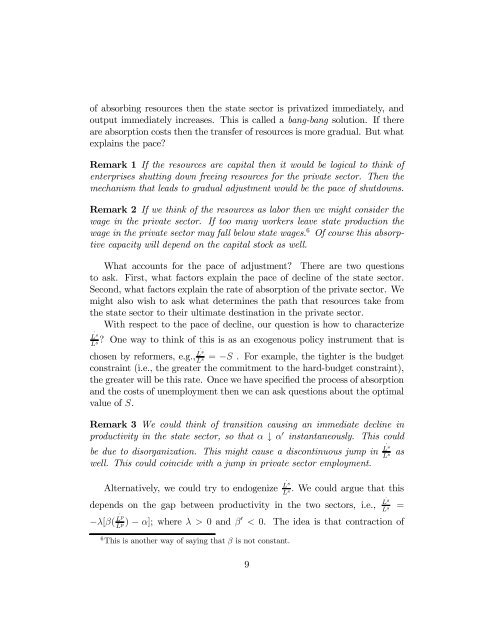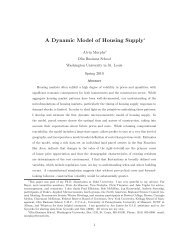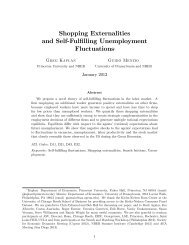Note on Adjustment and the Specific Factor Model
Note on Adjustment and the Specific Factor Model
Note on Adjustment and the Specific Factor Model
Create successful ePaper yourself
Turn your PDF publications into a flip-book with our unique Google optimized e-Paper software.
of absorbing resources <strong>the</strong>n <strong>the</strong> state sector is privatized immediately, <strong>and</strong>output immediately increases. This is called a bang-bang soluti<strong>on</strong>. If <strong>the</strong>reare absorpti<strong>on</strong> costs <strong>the</strong>n <strong>the</strong> transfer of resources is more gradual. But whatexplains <strong>the</strong> pace?Remark 1 If <strong>the</strong> resources are capital <strong>the</strong>n it would be logical to think ofenterprises shutting down freeing resources for <strong>the</strong> private sector. Then <strong>the</strong>mechanism that leads to gradual adjustment would be <strong>the</strong> pace of shutdowns.Remark 2 If we think of <strong>the</strong> resources as labor <strong>the</strong>n we might c<strong>on</strong>sider <strong>the</strong>wage in <strong>the</strong> private sector. If too many workers leave state producti<strong>on</strong> <strong>the</strong>wage in <strong>the</strong> private sector may fall below state wages. 6 Of course this absorptivecapacity will depend <strong>on</strong> <strong>the</strong> capital stock as well.What accounts for <strong>the</strong> pace of adjustment? There are two questi<strong>on</strong>sto ask. First, what factors explain <strong>the</strong> pace of decline of <strong>the</strong> state sector.Sec<strong>on</strong>d, what factors explain <strong>the</strong> rate of absorpti<strong>on</strong> of <strong>the</strong> private sector. Wemight also wish to ask what determines <strong>the</strong> path that resources take from<strong>the</strong> state sector to <strong>the</strong>ir ultimate destinati<strong>on</strong> in <strong>the</strong> private sector.With respect to <strong>the</strong> pace of decline, our questi<strong>on</strong> is how to characterize·L s? One way to think of this is as an exogenous policy instrument that isL s Lchosen by reformers, e.g., · s= −S . For example, <strong>the</strong> tighter is <strong>the</strong> budgetL sc<strong>on</strong>straint (i.e., <strong>the</strong> greater <strong>the</strong> commitment to <strong>the</strong> hard-budget c<strong>on</strong>straint),<strong>the</strong> greater will be this rate. Once we have speciÞed <strong>the</strong> process of absorpti<strong>on</strong><strong>and</strong> <strong>the</strong> costs of unemployment <strong>the</strong>n we can ask questi<strong>on</strong>s about <strong>the</strong> optimalvalue of S.Remark 3 We could think of transiti<strong>on</strong> causing an immediate decline inproductivity in <strong>the</strong> state sector, so that α ↓ α 0 instantaneously. This couldLbe due to disorganizati<strong>on</strong>. This might cause a disc<strong>on</strong>tinuous jump in · sasL swell. This could coincide with a jump in private sector employment.LAlternatively, we could try to endogenize · s. We could argue that thisL s·L sL s =depends <strong>on</strong> <strong>the</strong> gap between productivity in <strong>the</strong> two sectors, i.e.,L−λ[β( · p) − α]; whereλ>0 <strong>and</strong> β 0 < 0. The idea is that c<strong>on</strong>tracti<strong>on</strong> ofL p6 This is ano<strong>the</strong>r way of saying that β is not c<strong>on</strong>stant.9
















